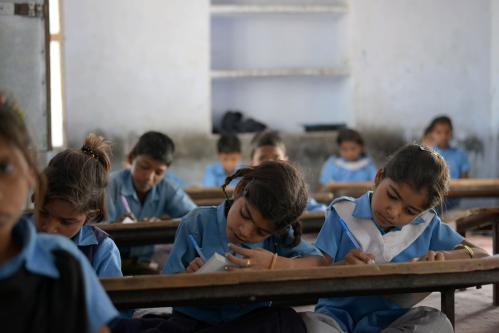2017 was an exciting year for social and development impact bonds around the globe, with 32 new contracts signed. This brings the total up to 108 contracted impact bonds globally, along with many more in design. This year also marked the contracting of the first social impact bond (SIB) in a low- or middle-income country, the Workforce Development SIB in Colombia, and a total of five development impact bonds (DIBs) have now been contracted, where the outcome funder is a third party, rather than a government entity.
While the market is expanding, there are key questions that remain: Can impact bonds be used at scale? Are they more effective than input-based based financing or than traditional payment-by-results? Do the actors in social service provision have the capacity to adapt to the demands of financing tied to results, and the rigorous focus on performance management that this is likely to entail? This review provides a snapshot of what we have seen this year, as well as where we see the field moving.
What do we know about the existing impact bonds?
Of these 108 impact bonds, 102 are in high-income countries, and six are in low and middle-income countries. As Figure 1 shows, these impact bonds are spread across 25 countries, although more than a third (42) have been contracted in the U.K., the country that pioneered the impact bond model with the Peterborough SIB in 2010. The results were released this year, with reoffending of short-sentenced offenders down by 9 percent and the investors repaid in full. With 19 impact bonds already contracted, and more in design, the United States has also established themselves as a player in the field. Our contribution to a recent book published by Nonprofit Finance Fund and the Federal Reserve Bank of San Francisco explores in depth the history and growth of paying for results in the United States.
Figure 1: Impact bonds by country

The focus areas of these contracted SIBs and DIBs are spread across seven sectors, although Social Welfare and Employment make up over 70 percent of the total. This year saw considerable growth of impact bonds in the health sector, with eight new impact bonds contracted—more than half of the total impact bonds for health contracted to date. These included an impact bond for maternal and newborn health in Rajasthan, and an impact bond in the Netherlands for re-integrating cancer patients into the workforce. In December, we explored how impact bonds can be used in the health sector as well as the potential to use impact bonds to find cures for disease.
Figure 2: Impact bonds by sector

More than half of the contracted impact bonds with available data serve 600 people or fewer, and as Figure 3 shows, 6 impact bonds serve 10,000 or more people. Only two impact bonds have more than 20,000 beneficiaries: the Maternal and Newborn Health DIB in Rajasthan, India, with 600,000 and the DC Water environmental impact bond, with 650,000. The total sum of upfront capital invested across the impact bonds with available data is over $300 million.
Figure 3: Count of impact bonds by the number of beneficiaries

Impact bonds in developing countries
Six impact bonds have been contracted in developing countries –one of those a SIB and the remaining are DIBs. To summarize some key lessons from practitioners, we launched Impact Bonds in Developing Countries: Early Learnings from the Field, in collaboration with Convergence, in the margins of the U.N. General Assembly in New York in September. We were pleased to welcome Sir Ronald Cohen at the event to speak on the state of play in the field. The full report features a Deal Book of impact bonds contracted and in design in developing countries, and we summarized the key findings in this blog post.
Impact bonds (both those contracted and those in design) in developing countries demonstrate some differing trends compared to those in high-income countries. In contrast to the domination of the social welfare and employment sectors in high-income countries, the health sector has emerged as a crucial sector for impact bond financing in developing countries: of 28 impact bonds, either contracted or in design, 11 are in the health sector. The majority of these impact bonds are in Africa (12) or Latin America (7). Another Brookings report, produced jointly with Ethos Laboratorio de Politicas Publicas, explored the potential for impact bonds in Mexico.
There are important differences in the types of outcome funders that have been engaged thus far in developing country contexts; while high-income country outcome funders are all government entities, in low and middle-income countries these include foundations, such as the Conrad N. Hilton Foundation, the Children’s Investment Fund Foundation (CIFF), and donor agencies such as USAID, the World Bank Group, and DFID. There are, however, several examples of domestic government outcome funders in low and middle-income countries, particularly for the impact bonds contracted and in design in Latin America: for example, the Government of Colombia is an outcome funder for the Workforce Development SIB contracted last year.
While impact bonds in developing countries are still quite young, the second year results from the Educate Girls DIB were released in July, with enrollment at 88 percent of the target and learning progress at 50 percent of the target, with another year of the intervention to go. We hosted a webinar to discuss these results, featuring presentations from Educate Girls (the service provider); UBS Optimus (the investor); Instiglio (the intermediary) and CIFF (the outcome funder). More details about the year two results can also be found in this blog post.
What’s next for impact bonds?
One of the criticisms of impact bonds that we hear most frequently is that they demand a considerable time commitment and a steep learning curve from the actors engaged in the contracting process. As a nascent field, and as a structure which tends to involve a wide variety of actors, impact bonds may be considered too slow or unwieldy in particular for their relatively small size to date. This limitation has led to calls for outcome funds, or the rate card approach, which could bring together funding from multiple actors interested in tying financing to results and provide an opportunity for larger scale. Outcome funds are currently under discussion for education and refugees, which would have the potential to finance multiple outcomes-based contracts on the same issue areas. In the U.K., the government has launched six outcomes funds, and efforts are underway in the U.S. to develop outcomes rate cards such as the one below, which allow the outcome funder to set prices for desired social outcomes, and then to contract with service providers to deliver interventions to achieve these results.
Example of an illustrative outcomes rate card:
| Outcome (per at-risk youth ages 14-24) | Maximum Outcome Price |
|---|---|
| Improved behavior at school | $500 |
| Completed Level 1 certification | $800 |
| Completed Level 2 certification | $1,300 |
| Entry into first employment | $2,000 |
| Entry into first employment (per high-risk of reoffending individual) | $3,000 |
| Employment retention (12 months) | $2,500 |
Source: Social Finance
Other actors have already been working on adapting the impact bond model further, and moving past the requirement to engage upfront capital from private investors. The Village Enterprise DIB, which provides training and grants to ultra-poor households in Kenya and Uganda to support their escape from poverty, is one example of a model taking a different approach. The structure did not require service providers to raise upfront capital, but left the decision in their hands (technically meaning that it is an outcome-based contract and not a DIB) – this arrangement means that service providers can take on the risk of the deal themselves, seek private investment, or secure traditional donor funding.
It is our prediction for 2018 that outcomes focused financing will increasingly become the norm in social services contracting in high-income countries. The slower pace of take-up in low and middle-income countries will be propelled by a rise in commitment from the largest donor agencies who face pressure to achieve the targets set for the Sustainable Development Goals by 2030. Given observed experience thus far in the eight years of impact bond implementation globally, however, commitment must come with action and hard work. Changing the paradigm of development finance on a larger scale will require realignment in the definition of success and impact for governments, donors, and service providers alike.
The Brookings Institution is committed to quality, independence, and impact.
We are supported by a diverse array of funders. In line with our values and policies, each Brookings publication represents the sole views of its author(s).


![Photo: The colors of the Colombian flag are reflected in a canal next to the convention center in Cartagena, Colombia. [Reuters/Jaime Saldarriaga]](https://www.brookings.edu/wp-content/uploads/2017/03/colombia_flag002.jpg?quality=75&w=500)







Commentary
Paying for social outcomes: A review of the global impact bond market in 2017
January 17, 2018